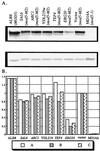Competition between a sterol biosynthetic enzyme and tRNA modification in addition to changes in the protein synthesis machinery causes altered nonsense suppression
- PMID: 10618371
- PMCID: PMC26616
- DOI: 10.1073/pnas.97.1.61
Competition between a sterol biosynthetic enzyme and tRNA modification in addition to changes in the protein synthesis machinery causes altered nonsense suppression
Abstract
The Saccharomyces cerevisiae Mod5 protein catalyzes isopentenylation of A to i(6)A on tRNAs in the nucleus, cytosol, and mitochondria. The substrate for Mod5p, dimethylallyl pyrophosphate, is also a substrate for Erg20p that catalyzes an essential step in sterol biosynthesis. Changing the distribution of Mod5p so that less Mod5p is present in the cytosol decreases i(6)A on cytosolic tRNAs and alters tRNA-mediated nonsense suppression. We devised a colony color/growth assay to assess tRNA-mediated nonsense suppression and used it to search for genes, which, when overexpressed, affect nonsense suppression. We identified SAL6, TEF4, and YDL219w, all of which likely affect nonsense suppression via alteration of the protein synthesis machinery. We also identified ARC1, whose product interacts with aminoacyl synthetases. Interestingly, we identified ERG20. Midwestern analysis showed that yeast cells overproducing Erg20p have reduced levels of i(6)A on tRNAs. Thus, Erg20p appears to affect nonsense suppression by competing with Mod5p for substrate. Identification of ERG20 reveals that yeast have a limited pool of dimethylallyl pyrophosphate. It also demonstrates that disrupting the balance between enzymes that use dimethylallyl pyrophosphate as substrate affects translation.
Figures



References
Publication types
MeSH terms
Substances
LinkOut - more resources
Full Text Sources
Other Literature Sources
Molecular Biology Databases

